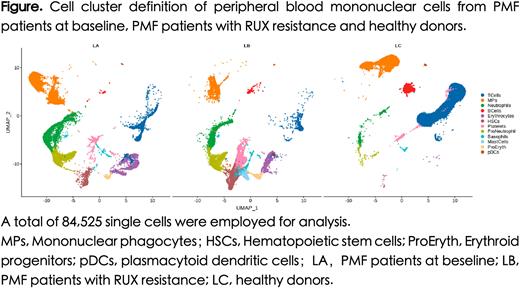Abstract
BACKGROUND: Primary myelofibrosis (PMF) is often but not always harbored JAK2, CALR, or MPL mutations. Mainly clinical features involve bone marrow reticulin/collagen fibrosis, hepatosplenomegaly, extramedullary hematopoiesis (EMH) and shortened survival. Ruxolitinib (RUX) is one of significantly current therapeutics for PMF by selective inhibiting of Janus kinase (JAK) 1 and 2. RUX-intolerant contribute to the deterioration of PMF. Hence, more therapeutic interventions require refined dissection during the development of RUX resistance at either cellular or transcriptional levels.
AIMS: Our objective is to elucidate the cellular constitution and transcriptional alterations presenting in peripheral blood (PB) obtained from PMF patients with/without RUX resistance.
METHODS: By analyzing the transcriptomes of 84,525 single cells and identifying major mononuclear cell types from peripheral blood of healthy donors (HD, n=2), PMF patients at baseline (BL, n=3) and PMF patients with ruxolitinib resistance (RUX-r, n=3) on the basis of their molecular signatures, the spatiotemporal interplay among cell types was characterized.
RESULTS: We illustrated the dynamics of all major PB mononuclear cell (PBMC) types, including T cells, mononuclear phagocytes, neutrophils, hematopoietic stem cells,basophil,plasmacytoid dendritic cells, erythrocytes progenitors and macrophages, so as those of their subtypes ,respectively,among the progression of RUX resistance. RUX-r and BL presented a statistically significant decrease in T cell and B cell compared with HD, respectively. Meanwhile, compared to HD, neutrophils, HSCs and Erythroid progenitors were dramatically increased in both BL and RUX-r. Interestingly, numbers of MPs displayed a statistically significant reduction in RUX-r and significant increase in BL compared to HD, respectively. Further analysis showed a significantly higher proportion of CD+T cells naïve in RUX-r. Cellular crosstalk analysis uncovered stagewise utilization of PBMC during the procession of RUX resistance. Specifically, mononuclear phagocyte inactivation and subtype switching was considered as an essential event in patients with RUX resistance.
CONCLUSIONS: Taken together, this study not only demonstrated dynamically changing cell type crosstalk during the progression of RUX resistance but also shed light on potential therapeutic strategies for RUX resistant primary myelofibrosis patients.
Disclosures
No relevant conflicts of interest to declare.
Author notes
Asterisk with author names denotes non-ASH members.


